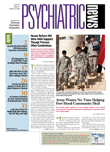Having an extra copy of 28 genes located on a particular area of chromosome 16 confers a potent risk of developing schizophrenia. The risk is at least eight times greater than in individuals who lack an extra copy of these genes.
This finding was reported online October 25 in Nature Genetics by an international team of geneticists. The senior investigator was Jonathan Sebat, Ph.D., of Cold Spring Harbor Laboratory in Cold Spring Harbor, N.Y., and the lead investigator was Shane McCarthy, Ph.D., a postdoctoral researcher in Sebat's lab.
The researchers arrived at their finding after comparing genetic material from some 11,000 subjects—4,600 with schizophrenia and 6,400 without it.
The group of genes associated with schizophrenia is located on an area of chromosome 16 called 16p11.2. “This region joins a growing list of genomic hot spots that confer high risk for the disorder,” the researchers said in their paper. For instance, if chromosomes 1 and 15 are lacking certain portions of their genetic material, then one's risk of having schizophrenia increases anywhere from seven to 18 times over what it would be if one did not have such deletions, they noted.
The researchers also integrated genetic data from their cohort with genetic data from 8,590 individuals with schizophrenia, 2,172 with autism, 4,822 with bipolar disorder, and 30,492 controls. These data were in the public domain.
The researchers then used the combined genetic data to see whether having an extra copy of the genes located at the 16p11.2 site on chromosome 16 could be linked with autism, bipolar disorder, or schizophrenia. They found that such a relationship did exist, although it was stronger for autism than for bipolar disorder.
The researchers then looked to see whether lacking the genes located at the 16p11.2 site of chromosome 16 could also be linked to schizophrenia, autism, and bipolar disorder. The answer was yes for autism, but no for schizophrenia and bipolar disorder.
So the take-home message, Sebat told Psychiatric News, is this: “The same genes on chromosome 16 can give rise to all of the three disorders, but the clinical outcome differs depending on how the DNA is altered. The duplication is associated with schizophrenia, bipolar, and autism … . The deletion is specifically associated with … autism.” So, in some ways, autism and schizophrenia may be “two sides of the same coin,” he said.
But how might having too many or not enough copies of these genes predispose people to schizophrenia, autism, or bipolar disorder? Out of the 28 genes, 17 are known to be expressed in the mammalian brain, including a number with potential roles in neurodevelopment, the researchers pointed out.
Furthermore, one or more of these genes may influence the development of head circumference. The reason to suspect that this might be the case is that when the researchers compared the head circumferences of 23 subjects lacking the genes at 16p.11.2 with American population head circumference averages, they found that the former were significantly larger. This finding agrees with previous ones that found that subjects with autism tend to have larger-than-average head circumferences.
Sebat and his team are now going to try to identify the specific biological processes affected by having too many or too few copies of the genes located at 16p11.2. They will begin by studying gene expression in blood samples taken from subjects with too many or too few copies of the genes, he said.
The study was funded by the National Institute of Mental Health.
